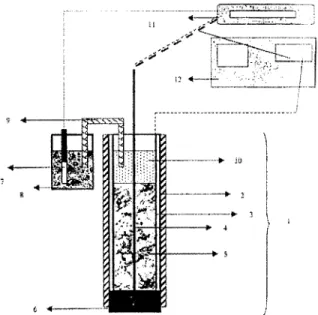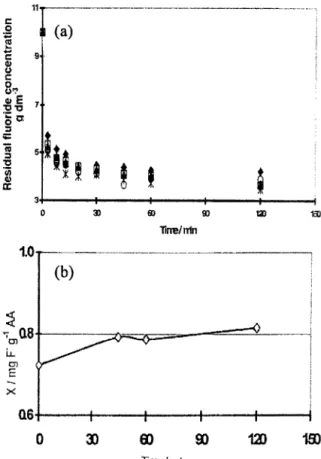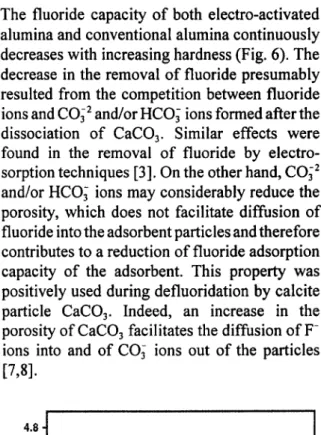Fluoride removal with electro-activated alumina
H. Lounici”, D. Belhocinea, H. Grib’, M. Drouiche”, A. Paussb,
N. Mamerib*
“Ecole Nationale Polytechnique dillger, B.P. 182-16200, El Harrach, Alger, Algeria“DPpartement GEnie chimique, University of Technology of Compiggne, B.P. 20.509, 60205 CompiGgne cedex, France Tel. +33 (3) 44 23 44 57; Fox: +33 (3) 44 23 52 16; email: nabil.mameri@utc.j?
Received 15 November 2002; accepted 10 February 2003
Abstract
A new activation technique using alumina was developed for the removal of fluoride from water. This technique is based on an electro-activation by means of an electrical field. The optimum activation parameters (potential and contact time) were determined, and an activation time of about 120 min and a potential of +lOO mV/SCE were then selected. The effect of various experimental parameters - ionic strength, pH hardness, and fluoride-alumina concentration ratio GGb- was determined for the adsorption capacities ofthe electro-activated alumina. The effect ofthese parameters on the fluoride adsorption capacities of both electro-activated adsorbent and conventional alumina was essentially the same, except for the ionic strength parameter. Indeed, ionic strength did not have a considerable effect on the performance of the conventional alumina. However, for the electro-activated alumina, an increase in ionic strength induced a slight increase in the fluoride adsorption capacity ofthe electro-activated adsorbent. The optimum conditions, determined in the batch mode, gave an optimal pH ranging from 3.5 to 5 and a C,,/C, ratio of about 4. At a NaCl concentration of 800 mg dm3, the fluoride adsorption capacity of the electro-activated alumina was about 55% better than that of conventional alumina.
Keywordrs: Adsorbent activation; Electrochemical technique; Fluorine; Alumina
1. Introduction adsorption capacity of a bed adsorbent. Under the
Electrosorptive techniques have been used to treat various contaminated waters [l-4] and/or to deionize water [5,6]. In a previous work, the authors demonstrated that the electrosorptive technique may be introduced to increase the
chosen electrical potential, however, the adsor- bent capacity was lower than that obtained without electrical potential. This result may be used to improve the performance of adsorbent bed regeneration [3].
The aim of this study is to propose a new
*Corresponding author.
activation technique for alumina based on application of an electric field, which ameliorates
001 l-9164/04/$- See front matter Q 2004 Elsevier Science B.V. All rights reserved
288 H. Lounici et al. /Desalination 161 (2004) 287-293
significantly the performance of this adsorbent. In this study we investigate the effectiveness of electro-activated alumina for removing fluoride from water and determine the optimum con- ditions in the batch mode.
2. Materials and methods
Acid activated alumina (AA) with a particle
size of 63-200 urn (purchased from Merck-Paris,
France) was soaked overnight in distilled water before the beginning of each experiment. The
main characteristics ofthe activated aluminaused
as an adsorbent are presented in Table 1.
2. I. Electra-activation apparatus
The electro-activation experiments were realized with an electrochemical cell designed in
our laboratory (Fig. 1). This apparatus was
equipped with two stainless-steel electrodes
utilized as working and auxiliary electrodes.
They were introduced into a PVC column (2 cm
in diameter and 20 cm long) to produce an electrical field in the AA bed. Previously, the column was filled with a wet AA, and a
conductive solution was added until contact with
the salt bridge was assured. An electrochemical
potential was then maintained constant during a chosen activation time by means of a Tacussel
PRT20-2X potentiostat. The electrochemical potential applied was measured by means of
saturated calomel electrode (SCE), as reference and working electrodes. The electro-activated alumina was then tested in batch mode and its performance was compared to conventional AA.
2.2. Fluoride kinetic adsorption
The second step consisted in quantifying the adsorption capacity of the adsorbent with and without electrochemical activation. Comparison
between electro-activated alumina and conven- tional AA was achieved by determining their
4
f II
L *.---...
Fig. 1. Electrochemical apparatus utilised for alumina activation. 1 electro-activation cell, 2 PVC column, 3 auxiliary electrode, 4 working electrode, 5 adsorbent: activated alumina, 6 glass wool, 7 reference electrode, 8 KC1 3M, 9 bridge salt, 10 conductive solution, 11 Mil- livoltmeter, 12 potentiostat.
Table 1
Physico-chemical characteristics of activated alumina
Parameter Value
Moisture, % 0
Density, g cme3 3.13 Total porosity, % 66 Activation type Acid Specific surface, m2 g-’ 250
fluoride kinetic adsorption under various experi- mental parameters: ionic strength, pH, hardness
and fluoride-alumina concentration ratio (C,,/C,) ratio. The apparatus utilised for this purpose consisted of a five-position electromagnetic stirrer equipped with a speed controller which
was adjusted to 350 rpm.
The experiments were carried out in a batch
was added to a synthetic fluoride solution (volume 0.5 dm3 ) until an adsorption equilibrium was reached.
Synthetic sodium fluoride (Prolabo, Paris, France) solutions were prepared with distilled water. During experimentation, in most cases the initial fluoride concentration (Ci) and adsorbent
concentration (C,) were fixed at 10 mg dmd3 and
8 g dmF3, respectively. The equilibrium and kinetic curves were drawn by following the evolution of residual fluoride concentration at regular short intervals. The adsorption capacity of the adsorbent (X) was calculated by the following equation, using the residual concen- tration reached at the equilibrium state (C,,), the
initial fluoride concentration and the adsorbent concentration in the reactor.
x= (Ci - C,) / CA (1)
Fluoride concentration was determined by an ionometric method with the PF4L specific fluoride electrode from Tacussel (Lyon, France). To minimize the effect of interfering ions (A13+, Fe3’, Cu’+, Ca2’,...), a total ionic strength adjuster buffer (TISAB) (pH = 5.5) was added to the samples.
3. Results and discussion
3.1. Electra-activation
In the first step, the ability of the AA to remove fluoride ions from water was tested with various potentials ranging from +200 to - 100 mV/SCE during a fixed activation time of about 60 min. The effect of the potential on the performance of the adsorbent was determined by following the kinetics of the water defluoridation at pH 7 (Fig. 2a). The results indicate that the limiting values of fluoride concentration were reached after 120 min. A contact time of 2 h was thus selected as the equilibrium time for all the
following experiments, the residual concentration
being constant until 360 min.
0 50 100 Tlme(min)
(b)
Oago
r-
- 0.70
2
7
m
L.
r
x 0.50
0.30 -100 0 100 200 Potential (mVIEcs)Fig. 2. Effect of the potential on adsorption kinetics and
adsorbent capacity. pH = 7, C,- = 10 mg dm-‘, CA = 8 g
dmm3, T = 2YC and T, = 60 min. (a) Kinetic curves at
various potentials (0) E = - 100 mV/SCE, (0) E = 0
corresponds to conventional AA, ( n ) E = +lOO mV/SCE,
(0) E = +200 mV/SCE. (b) Fluoride adsorption capacity
290 H. Lounici et al. /Desalination 161 (2004) 287-293
These curves made it possible to identify the potential E = +lOO mV/SCE as an optimum potential which gave the lowest value of residual fluoride concentration. The zero potential repre- sents the conventional A.A, i.e., without electro- chemical activation; this makes it easy to compare performance of the electro-activated adsorbent and conventional adsorbent. Calcu- lation of the fluoride adsorption capacity of the adsorbent for various potentials, presented in Fig. 2b, confirms that electrochemical activation may be used to improve adsorbent performance at potentials of about E = +100 mV/SCE. Indeed, an increase in the fluoride adsorption capacity of about 20% was obtained by activation at the potential of E = +lOO mV/SCE. These results are in agreement with those obtained previously in continuous mode using an electrosorption column. In this last case the optimum potential was assumed, by analogy to electrocapillary curves [3], to be the potential of zero charge (PZC) of the fluoride-AA system. On the other hand, the performance of the electro-activated adsorbent at the potential E= - 100 mV/SCE was less than that of conventional alumina. The decrease in the adsorption capacity as the activation potential decreases from 100 to - 100 mV/SCE may be explained by the charge state of the adsorbent.
The effect of the activation time (or contact
time in electro-activation) ofthe adsorbent during
electro-activation on the performance of the
electro-activated alumina was tested. The kinetic
curves obtained by following the variation of the residual fluoride concentration for various acti-
vation times indicate that the concentrations were
essentially similar with contact times longer than 40 min (Fig. 3a). The fluoride capacity of the electro-activated adsorbent obtained at various
activation times, presented in Fig. 3b, confirmed
that a limiting value of the adsorption capacity of the adsorbent was reached after 40 min. This activation time was thus selected for all the
.
s
.-
5
ib (4
z
f
9,
$
1
.-..:
Fig. 3. Effect of activation time on defluoridation kinetics and adsorbent performance. pH = 7, C,- = 10 mg dm-‘, CA = 8 g dme3 and T= 25T. (a) Kinetic curves at various activation times: (+) T, = 0 min ( n ) T, = 45 min, ( A ) T, = 60 min, (x) T, = 90 min, (*) T, = 120 min. (b) Fluoride adsorption capacity (X) against the activation time.
following experiments, since the fluoride capacity of the electro-activated alumina is constant up to 120 min.
3.2. Effect of experimental parameters on the electro-activated alumina
The influence of various experimental para-
meters [ionic strength, hardness, pH and fluoride
-alumina concentration ratio (C,JC,)] on the
performance ofthe electro-activated alumina was
The effect of the ionic strength of the solution
on the adsorbent performance was investigated at
pH 7 by using three different NaCl concen- trations ranging from 200 to 800 mg dm-3. Practically similar defluoridation kinetics were obtained at various NaCl concentrations for the conventional activated alumina, indicating that the ionic strength did not have a considerable effect on the performance of this adsorbent (Fig. 4); a slight decrease was obtained at the
higher salt concentration of 800 mg dme3. How-
ever, for the electro-activated alumina, an increase in the ionic strength induced a slight increase in the fluoride adsorption capacity ofthe
electro-activated adsorbent. The fluoride adsorp-
tion capacity of an electro-activated alumina may
be improved by about 20% with a NaCl concen-
tration of 800 mg dmW3, as compared with that
obtained with fluorinated solutions without the addition ofNaC1. These results are of interest for the treatment of strongly mineralized ground water found in the North African Sahara [ 11. On the other hand, an increase in salt concentration improved the performance of the adsorbent
treated by the electrochemical process. At aNaC1
concentration of 800 mg dme3, the fluoride adsorption capacity of the electro-activated alumina was about 55% greater than that of the
conventional alumina. The concentration depend-
ence of the adsorption capacity of the electro- activated adsorbent may be explained by the change ofthe charge state ofthe electro-activated adsorbent at various salt concentrations.
The effect of the pH of the solution on the adsorbent performance was investigated for pH ranging from 2 to 11. The results, presented in Fig. 5, indicate that the fluoride adsorption capacity of both electro-activated and conven- tional alumina decreases at pH superior to 4. These results could be explained by the change of the charge state under the various pH. A similar
decrease in fluoride adsorption was observed for
strongly acid solutions with pH less than 3. These
0.4 , $ 0 200 400 600 800 1000
NaCl concentration f mg dmJ
Fig. 4. Effect of the ionic strength on the fluoride adsorption capacity(x). pH = 7, C,- = 10 mg dm-‘, CA = 8 g dmm3, T, = 120 min, T = 2YC. (Cl) electro-activated alumina and (0) conventional alumina.
1.2--
04 t
0 2 4 6 a 10 12 PH
Fig. 5. Effect of the pH on the fluoride adsorption capacity (A’). pH = 7, C; = 10 mg dm-‘, CA = 8 g dme3, T, = 120 min, T = 25°C. (0) electro-activated alumina and (0) conventional alumina.
292 H. Lounici et al. /Desalination 161 (2004) 287-293
results could be attributed to the formation at high acidity of an adsorbed negatively charged layer by means of HF and I-IF,- which would
decrease the adsorbent capacities by electrostatic
repulsion of fluoride. The performance of the electro-activated alumina was better than that obtained with conventional alumina for the range of pH utilized. It should be noted that an optimum pH region ranging from 3.5 to 4.5 was determined for fluoride removal by adsorption on
both electro-activated and conventional alumina.
An optimum pH 4 was utilised for all the following experiments.
The effect of the hardness of the water on the
performance of the adsorbent submitted to electrochemical activation was measured by adding calcium carbonate (CaCO,) salt which conferred hardness in the range of 0 to 400 mg
dmm3 of CaCO, to the synthetic fluorinated water.
1 0.8 I: 7 L" F 2 0.6 ‘ 0 400 500 Hardness I mg CaC03 dm’ O.@ 1 3 5 7 9 11 CF-/CA I mg F g” AA
Fig. 6. Effect of hardness on the fluoride adsorption Fig. 7. Effect concentration ratio (C,,,/C,)on the fluoride capacity (x). pH = 4, C; = 10 mg dme3, C, = 8 g dm-‘, adsorption capacity(x). pH = 4, T, = 120 min, T= 25°C.
T, = 120 min, T = 25°C. (0) electro-activated alumina (0) electro-activated alumina and (0) conventional
and (0) conventional alumina. alumina.
The fluoride capacity of both electro-activated alumina and conventional alumina continuously
decreases with increasing hardness (Fig. 6). The
decrease in the removal of fluoride presumably
resulted from the competition between fluoride ions and CO;* and/or HCO; ions formed after the dissociation of CaCO,. Similar effects were found in the removal of fluoride by electro- sorption techniques [3]. On the other hand, CO;* and/or HCO; ions may considerably reduce the porosity, which does not facilitate diffusion of
fluoride into the adsorbent particles and therefore
contributes to a reduction of fluoride adsorption capacity of the adsorbent. This property was positively used during defluoridation by calcite particle CaCO,. Indeed, an increase in the porosity of CaCO, facilitates the diffusion of F- ions into and of CO; ions out of the particles [7,81.
4.8 3.8
The influence of the concentration ratio (CJC,) on the performance of the fluoride adsorption technique, presented in Fig. 7, shows an important increase in the fluoride adsorption
capacity for the two adsorbents when the Cr,/C,
ratio is increased up to 3 mg F-/gAA . Below this value, the performance of both adsorbents increased slightly. It is important to note that the higher the C&/C, ratio, the lower are the kinetics. These two parameters, i.e., adsorption capacity and kinetic reaction, then have to be balanced in order to choose an adequate value for the
concentration ratio R. In our case, a ratio of about
R= 4 mg F-/ g AA may be considered suitable for
fluoride removal for both adsorbents.
4. Conclusions
This study demonstrates the interest of using
electro-activation as a technique for improving the fluoride adsorption capacity of alumina. Indeed, this technique exhibited more efficiency than the conventional activation technique in all cases. Optimal conditions of the electro- activation operation were determined: an acti- vation time of about 2 h and a potential of +I00 mV/SCE. The effect of the experimental parameters on the fluoride adsorption capacities of both electro-activated adsorbent and conven- tional alumina was essentially the same, except for the ionic strength parameter. Indeed, ionic strength did not have a considerable effect on the performance of the conventional alumina. However, for the electro-activated alumina, an increase in the ionic strength induced an increase in fluoride adsorption capacity of the electro- activated adsorbent. Indeed, at a NaCl concen-
tration of 800 mg dmm3, the fluoride adsorption
capacity of the electro-activated alumina was about 55% greater than that of the conventional alumina. This result may be useful in the
treatment of ground waters of the North African
Sahara, which present a strong mineralization and
are contaminated by fluoride. Moreover, this study is pursued by determining the relation between the adsorption capacity and the charge state of the electroactivated adsorbent by means of the streaming potential technique.
5. Symbols CA - c, - ci - To - T - x - References Adsorbent concentration, g dmW3 Fluoride concentration at equili- brium state, mg dmv3
Initial fluoride concentration, mg dmm3
Activation time, s Temperature, “C
Fluoride adsorption capacity, mg F-/g AA VI PI [31 141 PI WI [71 181
N. Mameri, D. Belhocine, R. Yeddou, H. Grib, H. Lounici and B. Bariou, Wat. Res., 32 (1998) 1604. Z. Amor, S. Malki, M. Taky, A. Elmiddaoui, B. Bariou and N. Mameri, Desalination, 120 (1998) 263. H. Lounici, L. Addour, D. Belhocine, H. Grib, B. Bariou andN. Mameri, Desalination, 114 (1997) 241. A.A. Djakov, V. Yu. Rostovtsev, T.N. Perekhozheva, E.I. Zlokazova, N.N. Oshkanov, V.G. Morozov and V.A. Makhov, in: Proc. ASME/JSME International Conference on Nuclear Engineering, New Orleans,
1996.
J.C. Farmer, D.V. Fix, G.V. Mack, R.W. Pekala and J.F. Poco, in: Proc. International SAMPE Technical Conference, 27 (1995) 294.
J.C. Farmer, D.V. Fix, G.V. Mack, R.W. Pekala and J.F. Poco. J. Appl. Electrochem., 26( 10) (1996) 1007. O.R. Trautzand R.R. Zaparta, Arch. Oral. Biol. Spec. Suppl., 4 (1961) 122.
M. Yank, T. Hashimoto, N. Hoshi and H. Myoga, Wat. Res., 33(16) (1999) 3395.




